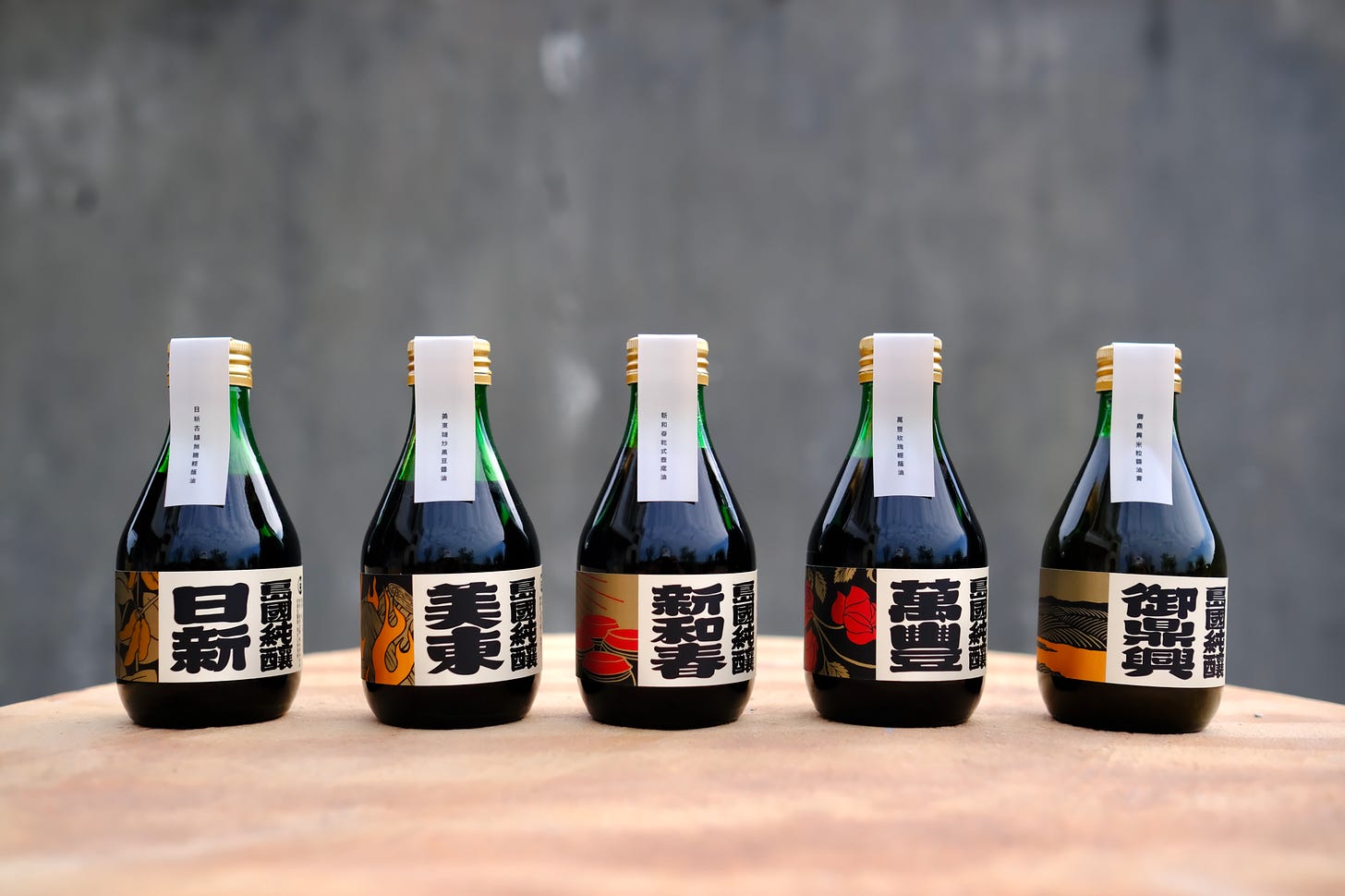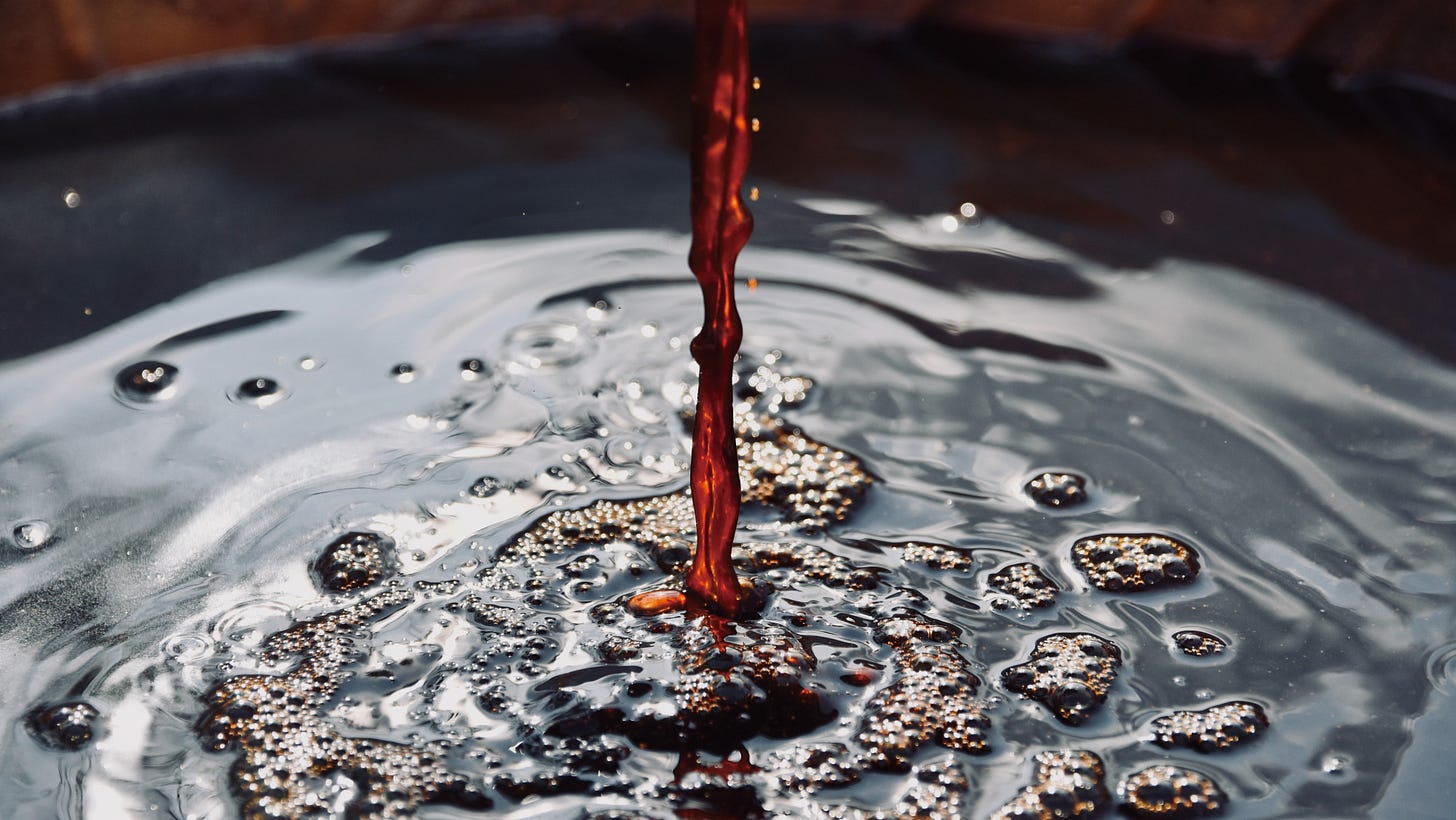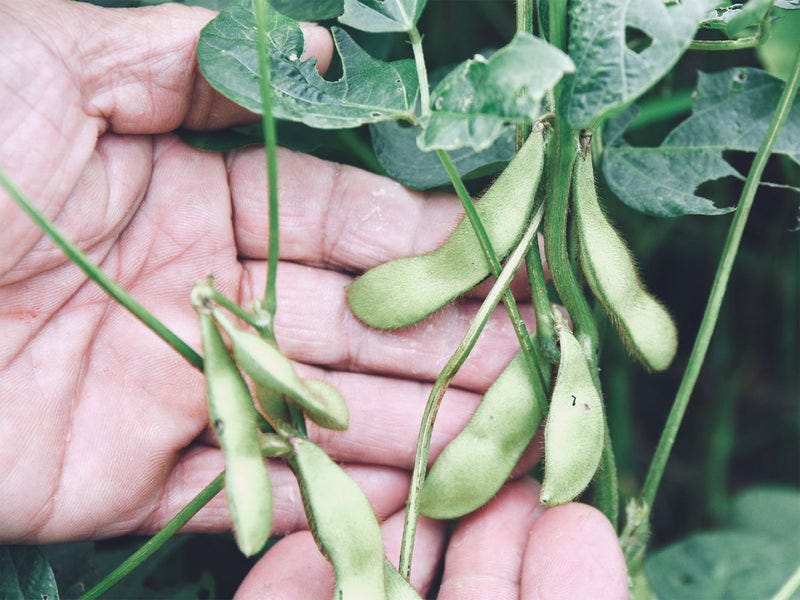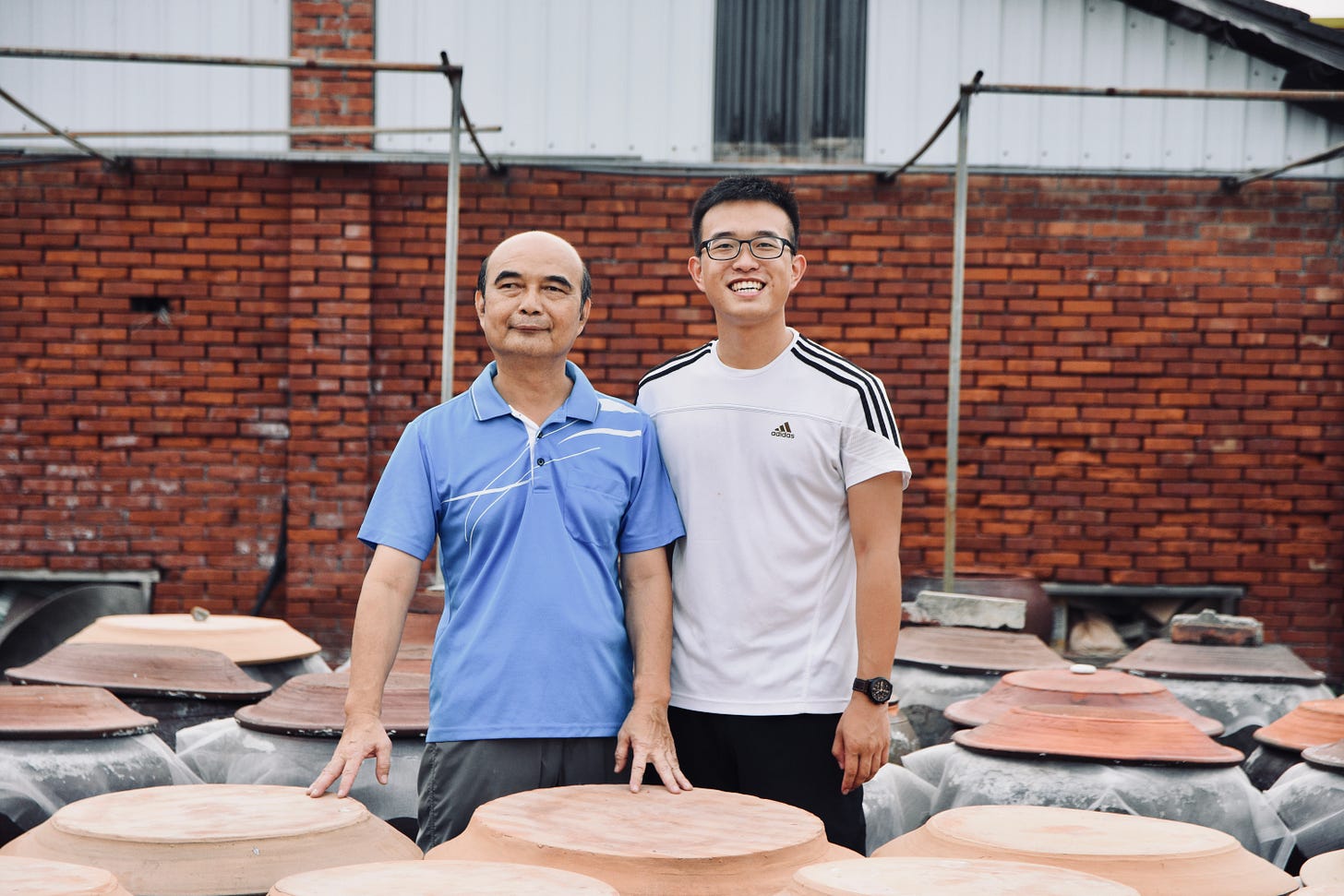黑豆油: Everything I Know About Taiwanese Soy Sauce, Part One
Plus, the launch of a limited edition, five-brewery soy sauce set exemplifying the terroir of Central Taiwan
This is Yun Hai Taiwan Stories, a newsletter about Taiwanese food and culture by Lisa Cheng Smith 鄭衍莉, founder of Yun Hai. If you aren’t yet a subscriber, sign up here.
This month, we launch the Taiwan Terroir Soy Sauce Set, a limited-edition box set featuring five artisanal breweries from Central Taiwan. To mark the occasion, I share a thing or two I’ve learned about Taiwanese soy sauce after years working with Yu Ding Xing 御鼎興, the family brewery that spearheaded this project. Scroll down all the way for a description of each brewery and the bottle they contributed.
I’m just going to go ahead and say it: natural soy sauce, like natural wine, should be thought of as its own manufacturing movement; it employs simple, traditional methods and limits the use of high-tech, industrialized practices. As Yi-Che Hsieh of Yu Ding Xing 御鼎興 tells it, it’s a difficult industry, a hard nut to crack, partially because the recognition and understanding of natural soy sauce is still developing, in Taiwan and across the world.
As in wine, coffee, tea, and olive oil, terroir plays a significant role in the flavor of a natural soy sauce. A term that originated in the wine industry, terroir is defined as the effect that place has on the character of a crop—literally “land,” as in the dirt they were grown in. The meaning has evolved to encompass all that a locale imparts. In the case of soy sauce, this includes the dirt, but also the sun, the fog, the courtyard, the microbial dialogue, and the beneficial, balanced environment carefully created by the craftsperson.
In November of 2021, Yu Ding Xing 御鼎興 and four other Central Taiwan breweries (pictured throughout this newsletter) collaborated on a tasting set to raise awareness about their craft. They specifically discussed how terroir or 風土 (translates to “wind and earth”) is significant to natural soy sauce, creating a rich ecosystem of flavor amongst breweries in Central Taiwan. Factors considered include koji strain, water source, local wood and crops, brew time, brine ratio, terracotta vats, and time in the sun, among others.
We imported a very limited quantity of these terroir tasting sets to share with you. Normally you’d have to spend several days in Central Taiwan to taste these, but this time the breweries are on tour.
As a purveyor, I know how exciting each bottle of natural soy sauce can be: the diversity in flavor; the unpredictability of the season; the somewhat unknowable final production quantity; the personality of the koji, 等等. All of the above contribute to the annual metamorphic drama that is natural soy sauce, depending deeply on the place of production and the bent of the brewer.
These five soy sauces are shockingly, delightfully different. But, they are all distinctly Taiwanese, a category of soy sauce left out of every Soy Sauce 101 online roundup I’ve come across (please forward this to every food editor you know).
So, without further ado:
What makes Taiwanese Soy Sauce Taiwanese?
An FAQ on the matter.
Q: What is unique about Taiwanese soy sauce?
A: Most commercial soy sauces are made from yellow soybeans and wheat, whereas traditional Taiwanese soy sauces are made from black soybeans only. That also means they are gluten-free, opening up many options for those with wheat sensitivities.
The flavor of black bean soy sauce is richer and rounder than commercial soy sauces, with an almost chocolatey feel. They are inherently saltier, because they have no artificial preservatives, so you don’t need to use as much. Finally, many Taiwanese soy sauces contain a touch of sugar to balance out the richness of the black bean. (In wheat-based soy sauces, the wheat is responsible for adding a sweet note.)
Q: What difference do black soybeans make?
A: Black soybeans yield a different flavor and nutritional profile. They have more protein than yellow soybeans and, when fermented, produce more glutamate (most famously known for its starring role in the feature film Monosodium Glutamate) and thus more umami flavor. The beans also have greater anti-oxidative properties than yellow soybeans due to an increased presence of phytochemicals, such as the pigment that makes it black (anthocyanins, the same thing that makes purple cabbage royal).
Black soybeans make a difference to Taiwan too. Most commercial soy sauce in Taiwan is made from soybeans imported from the US or China, which are more affordable and sometimes certified as organic, but ultimately have to travel far, are of unknown origin and reduce the self sufficiency of Taiwanese agriculture. Many natural soy sauce brewers have made a move back towards Taiwan-grown black soybeans, producing single-origin soy sauces with better flavor, imparting qualities of terroir, while also enabling local agriculture and greater food self-sufficiency. All beans used are non-genetically modified.
Q: Any relation to fermented black beans?
A: Yes! Fermented black beans, or 豆豉 (a key ingredient in fan-favorites Clams with Black Bean Sauce and Ma Po Tofu) are made from black soybeans, as well. In fact, to make Taiwanese soy sauce, you first have to make fermented black beans. These then get further fermented to produce soy sauce. The flavor profile of Taiwanese soy sauce is directly related to that of fermented black beans. Deep and of the earth but also fresh, zingy, and invigorating.
We ask Yu Ding Xing to set a batch of fermented black beans aside for us whenever they can spare them in their brewing process. We sell these, too, packed in salt, and I think they’re the best around.
Q: How is Taiwanese Soy Sauce made?
A: A year ago, we premiered Time, Terroir, Taiwan: Soy Sauce Brewing in XiLuo, a mini-documentary about Yu Ding Xing 御鼎興 I co-produced with Steve Chen, a Taiwanese-American filmmaker and architect. We made the film to show the nuanced, skillful, time-intensive process of making uniquely Taiwanese soy sauce. Watch it here to see the whole process.
Q: What if I don’t have time to watch your movie?
Ok, to paraphrase:
First, soybeans are pressure cooked, then inoculated with Koji culture. After a period of initial fermentation, the koji develops inside and on the beans, which grow yellow fuzz. These beans are carefully inspected, rinsed, mixed with salt and water, and packed into a terracotta vat to ferment for a year. After fermentation is complete, the brew is extracted, pressed, and heated over a wood fire to stop the fermentation process. It’s then bottled, labeled, and shipped. But you really should watch the documentary because the brewers are magnetic on screen and they run a tight ship. Like, nary a bean on the floor.
Q: What is unique about the Taiwanese brewing process?
A: Many things. Taiwan’s soy sauce brewing process is often described as “sun brewed” or 日曬. The terracotta vats sit covered in a brick-lined brewyard, exposed to sunlight for 6 months to a year. The heat generated from the sun is absorbed by the earthenware vessel, creating a a hot fermentation environment with high microbial activity. The soy sauce is ready relatively quickly compared to soy sauce fermented in cooler climates or indoors.
Additionally, there are both dry and aqueous brewing methods. In dry brewing (hyper-traditional) the inoculated soybeans are packed with salt, and that’s it. This kind of soy sauce is like Eau de Fermented Black Bean and is pure as can be (there’s one included in the set).
In aqueous brewing, the beans are submerged in a brine. This method results in a more developed, mellow flavor. Other things (like fruit) can be mixed in to influence the outcome.
And there is the hybrid of these, semi-aqueous, in which some water is added, but the top layer of beans is left dry. This method captures the aroma of the dry brewed black beans and the flavor developed in the brine.
Q: What is Vat Bottom Soy Sauce?
A: Short answer: Vat Bottom Soy Sauce is to Taiwan as Dark Soy Sauce is to Southern China, though it’s not a direct substitution, because Vat Bottom is saltier and less sweet. Both lend more color and aroma to braised and marinated dishes.
Long answer: Each terracotta vat is tapered at the bottom. Vat Bottom or 壺底 Soy Sauce comes from the lower part of the vat. Because the soy sauce isn’t stirred or disturbed during brewing, flavor particles settle at the bottom, creating a richer, darker brew. The finished soy sauce is removed in layers, and the bottom is set aside as Vat Bottom Soy Sauce. Taiwan doesn’t have “light” and “dark” soy sauce, but Vat Bottom is more suitable for braising, marinating, or anything where more color and flavor is desired. This kind of soy sauce must be brewed for one year for the particles to settle, and, because the vat is tapered, there’s relatively less of it.
Q: What is Soy Paste?
A: I’ve been waiting for years for someone to break the story on Soy Paste (aka Soy Sauce Paste aka Thick Soy Sauce aka 醬油膏 aka the world’s most convenient condiment). This is a uniquely Taiwanese ingredient that is indispensable, very hard to find in the US, and has an English name that is not Search Engine Optimized. It’s soy sauce that’s been thickened with glutinous rice (or other starch) and lightly sweetened, with a texture similar to oyster sauce. Use it as a dip, drizzle, glaze, and stir fry sauce, When eating in Taiwan, you’ll see it everywhere. I use this on average once a day. Try diluting 2 tablespoons with an equal amount of water and drizzling it over steamed Chinese broccoli for a quick side dish; I promise you’ll be hooked.
Q: I see a lot of bottles in the store marked as “naturally brewed.” Is this the same thing as the natural soy sauce you are describing?
A: Many commercial bottles are labeled “naturally brewed,” which indicate (as a baseline) that no chemicals were used to extract the soy sauce. Most of these are made, ever so naturally, by fermenting defatted soybean meal, a byproduct of soybean oil production, in an industrial process that involves pretreating (read: exploding) the meal to make it easier to break down and quicker to ferment. I’m not anti-food science, and inexpensive soy sauce is a necessity. But, the soy sauces I’m talking about here are the whole-bean, high-touch soy sauces fermented in decades-old terracotta vats, looked after daily by their watchful brewers. When the salt cap is cracked open after a year in the sun, the smell is so sweet, the honeybees come looking for the bouquet.
Taiwan Terroir Soy Sauce Set
According to Yi-Che Hsieh of Yu Ding Xing, “Making a bottle of traditional Taiwanese soy sauce is like writing a poem. Writing a poem requires hills and valleys, rhyme, and word constraints.”

Many breweries have been employing traditional practices for generations, but their comeuppance among general consumers in Taiwan is something of the now. Younger generations are moving back to their parents breweries to both preserve and revive their family businesses. Others are introducing new practices, such as statistical analysis, or incorporating non-traditional ingredients, to push the craft further. The general interest is so great that our documentary was licensed by an English language Taiwanese streaming network called Taiwan Plus, to be shared with domestic and overseas audiences alike. English-speaking audiences are more readily accepting high end Taiwanese and Chinese ingredients, as the cuisine is increasingly more well understood overseas. It’s a good time for soy sauce.
The Five Soy Sauce Bottles
Now that you know a bit more about Taiwanese soy sauce, here’s a rundown of each bottle in the terroir set:

Dry Aged Vat Bottom Soy Sauce
by Xin He Chun Soy Sauce 新和春醬油
She Tou, Chang Hua County
Zhang You Sheng, fourth generation brewer, insists on making soy sauce the most traditional way, dry brewing using only black beans and sea salt. The rich aroma of the soy sauce has been wafting in the air of She Tou for 120 years.

Soy Paste with Glutinous Rice Grains
by Yu Ding Xing Soy Sauce 御鼎興醬油
Location: XiLuo, YunLin County
Hsieh Yu Du, second generation brewer, utilizes both dry and aqueous brewing, blending the two methods together to deliver a sauce that is a cumulative expression of Central Taiwan’s terroir.

Rose-Infused Light Soy Sauce
by Wan Feng Soy Sauce 萬豐醬油
Location: Dou Liu, Yun Lin County
Wu Guo Bin, third generation brewer, uses statistical analysis to understand the characteristics of fermentation, seeking to balance the forces of heaven, earth, and koji cultivation. He also incorporates distinct ingredients such as organic rose or Taiwanese oil millet, an endemic plant, to create unique brews.

Black Soybean Sauce with Hand-Toasted Sugar
by May Dong Soy Sauce 美東醬油
Location: Dong Shi, Tai Chung County
Fu Hong Yan, third generation brewer, believes the process of making soy sauce should sync with natural cycles. The brewery is built on a hill with an orchard, where fruit tree branches are used as firewood to heat the soy sauce, and spent soybeans are returned to the orchard as fertilizer.

Traditional Light Black Soybean Sauce
by Ri Xin Soy Sauce 日新醬油
Location: Tu Ku, Yun Lin County
Huang Jia Yu, a fourth generation brewer, is a bold visionary. They contracted local farmers to grow black soybeans on a large scale to replace the use of imported beans in all of their products, in a considerable effort towards improving the self-sufficiency of Taiwan’s agriculture.
When I was a kid, my mom used to say: “We are a bean people.” I didn’t know what she meant and would laugh at the sound of it, because as far as I could tell, we weren’t eating beans in our Chinese food. Now here I am, about as bean-obsessed as it gets. Stay tuned for my Treatise on Tofu and Mung Bean Manifesto coming next week (I kid, I kid, who has that kind of time, I have a business to run).
From your resident Bean Person,
Lisa Cheng Smith 鄭衍莉
Exciting news! We have finally restocked the large size of our bestselling Nyonya Garlic Chili Sauce, one of the original products we started with. Made in Taiwan by a Nyonya garlic farmer, this sweet chili sauce suits everything from fried rice to dumplings. The large size comes with beautiful gift packaging, too.
If you enjoyed this newsletter, please share it with friends and subscribe if you haven’t already. We email once a month, sometimes more. For more Taiwanese food, head to yunhai.shop, follow us on instagram and twitter, or view the newsletter archives.

















Albert and I loved this post very much and shared your wonderful video here: https://ampleroad.substack.com/p/our-trio-to-xiluo-in-yunlin-county
I enjoyed reading this article so much!! Thank you for your wonderful writing and bringing the magic of Taiwan to us. Can't wait to read more from Yunhai!